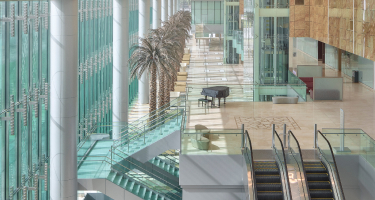Our Doctors
Meet all the doctors from Cleveland Clinic Abu Dhabi.
View Doctors

The spine (or backbone) runs from the base of the skull to the pelvis. It serves as a pillar to support the body's weight and to protect the spinal cord. There are three natural curves in the spine that give it an S shape when viewed from the side. These curves help the spine withstand great amounts of stress by providing a more even distribution of body weight.
The spine is made up of a series of bones that are stacked like blocks on top of each other with cushions called discs in between to help absorb shock/load.
The spine is divided into three regions:
Below the lumbar spine is a large bone called the sacrum. The sacrum actually consists of several vertebrae that fuse together during a baby's development in the womb. The sacrum forms the base of the spine and the back of the pelvis. Below the sacrum is a small bone called the coccyx (or tailbone), which is another specialized bone created by the fusion of several smaller bones during development.
The spine is sometimes discussed by parts: bones (and joints), discs, nerves, and soft tissues (ligaments, tendons, muscles).
Joints allow for movement, since bones themselves are too hard to bend without being damaged. Facet joints are the specialized joints that connect the vertebrae. The facet joints allow the vertebrae to move against each other, providing stability and flexibility. These joints allow us to twist, to bend forward and backward, and from side to side. Each vertebra has two sets of facet joints. One pair faces upward to connect with the vertebra above and the other pair faces downward to join with the vertebra below.
In the center of each vertebra is a large opening, called the spinal canal, through which the spinal cord and nerves pass. The vertebrae are held together by groups of ligaments, fibrous tissues that connect bone to bone.
Intervertebral discs are flat, round cushioning pads that sit between the vertebrae (inter means between or within) and act as shock absorbers. Each intervertebral disc is made of very strong tissue, with a soft, gel-like center ” called the nucleus pulposus ” surrounded by a tough outer layer called the annulus. When a disc breaks or herniates (bulges), some of the soft nucleus pulposus seeps out through a tear in the annulus. This can result in pain when the nucleus pulposus puts pressure on nerves.
The spinal cord, the column of nerve fibers responsible for sending and receiving messages from the brain, runs through the spinal canal. It is through the spinal cord and its branching nerves that the brain influences the rest of the body, controlling movement and organ function.
As the spinal cord runs through the spinal canal, it branches off into 31 pairs of nerve roots, which then branch out into nerves that travel to the rest of the body. The nerve roots leave the spinal cord through openings called neural foramen, which are found between the vertebrae on both sides of the spine. The nerves of the cervical spine control the upper chest and arms. The nerves of the thoracic spine control the chest and abdomen, and the nerves of the lumbar spine control the legs, bowel, and bladder.
Tendons connect muscles to bone and assist in concentrating the pull of muscle on bones. Ligaments link bones together, adding strength to joints. They also limit movements in certain directions. Muscles provide movements of the body and help maintain position of the body against forces such as gravity.
© Copyright 2017 Cleveland Clinic Abu Dhabi. All rights reserved.
This information is provided by Cleveland Clinic Abu Dhabi, part of Mubadala Healthcare, and is not intended to replace the medical advice of your doctor or health care provider. Please consult your health care provider for advice about a specific medical condition.
We’re here to make managing your healthcare easier.